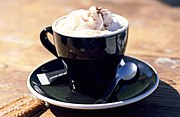Kapucino: Perbedaan antara revisi
~stub |
hapus inggris |
||
| Baris 15: | Baris 15: | ||
[[Berkas:A cappuccino.jpg|left|180px|thumb|Cappuccino]] |
[[Berkas:A cappuccino.jpg|left|180px|thumb|Cappuccino]] |
||
| ⚫ | |||
<!-- |
|||
The widespread acceptance in the U.S. of what was once regarded as a taste of coastal urbanites and older [[Italian-Americans]] has led to many establishments, such as [[convenience stores]] offering what they represent as cappuccino to their patrons. However, that product is usually an ersatz cappuccino, produced by machines similar to those that mix [[cocoa]] drinks where all the buyer need do is touch a button and position the cup properly. The drink that comes out is usually produced either from a preproduced mix or double-brewed coffee and bears little relation to the real thing. |
|||
Similar products result from home use of store-bought mixes usually advertised, more accurately, as producing "frothed coffee." |
|||
==Origins== |
|||
The origin of the name is in the brown hooded robes worn by the [[Capuchin]] order of [[Franciscan]] friars. The origin of the name is in the brown hooded robes worn by the [[Capuchin]] order of [[Franciscan]] friars. In [[France]] at the beginning of the [[18th century]] a new fashion arose in [[Paris]] (though not at [[Palace of Versailles|Versailles]]) for carved wall-panelling [[boiseries]] that were left in their natural color (almost invariably oak) rather than being painted and gilded as in the previous century. The new mode, which coincided with the height of the controversy over ''[[Jansenism|Jansenisme]]'' that was dividing the ''tout Paris'' in stylish religious pamphleteering, was wittily termed ''à la capucine'' in reference to the brown color of the robes worn by Franciscan friars. This color-coded etymology is followed by the [[Oxford English Dictionary]] and the [[American Heritage Dictionary]]. The order of Capuchins was, in turn, named for the ''capucize'' (''cappuccio''), or long pointed cowl, worn by the friars. Similarly, the cream on a well-made cappuccino covers the beverage as a sort of ''cappuccio.'' |
|||
Traditionalist Catholics find the etymology mildly disrespectful, and offer a twist on a familiar coffee legend: after the [[Battle of Vienna]] ([[1683]]) and the [[Ottoman Empire|Ottoman]] siege was lifted, the Capuchin friar [[Marco d'Aviano]] ([[beatification|beatified]] in April [[2003]]) invented the drink after the Turks retreated, leaving bags of coffee beans in their tents. Allegedly, d'Aviano added milk and [[honey]] to sweeten the bitter coffee left by fleeing Turkish armies, though for a Viennese of the [[17th century|17th]] or [[21st century]], coffee sweetened with honey would be an emblem of desperation. This same legend is more widely told of a Pole, Kolschitzky, in the aftermath of the Siege (see the entry [[Coffeehouse]]). |
|||
Cappuccino also comes in a ''freddo'' (cold) variety, where the steamed milk foam is substituted by stirred milk, indistinguishable from ''caffe latte''. |
|||
''See also'': [[Coffee]], [[caffé]], [[espresso]], [[flat white]] |
|||
[[Berkas:Cappuccino fredo.jpg|thumb|A glass of cappuccino ''freddo'']] |
|||
==External link== |
|||
*[http://www.toomuchcoffee.com/ Foaming techniques, FAQs on cappuccino and espresso] |
|||
*[http://www.dangray.org/index.php?id=11 How to make cappuccino] How to make cappuccino at home with domestic equipment --> |
|||
| ⚫ | |||
[[Kategori:Kopi]] |
[[Kategori:Kopi]] |
||
Revisi per 11 Desember 2009 16.34

Cappuccino adalah minuman khas Italia yang dibuat dari espresso dan susu. Cappuccino biasanya didefinisikan sebagai 1/3 espresso, 1/3 susu yang dipanaskan dan 1/3 susu yang dikocok hingga berbusa. Definisi yang lain menyebutkan 1/3 espresso dan 2/3 mikrofoam. Cappuccino berbeda dengan latte macchiato, yang kebanyakan terdiri dari susu dan sedikit busa. ("Cappuccino kering" mengandung lebih sedikit susu.)
Di Italia cappuccino diminum hampir selalu hanya pagi-pagi untuk makan pagi. Di beberapa negara lain cappuccino diminum sepanjang hari atau setelah makan malam.
Selain espresso yang baik, unsur terpenting dalam membuat cappuccino adalah tekstur dan temperatur susu. Bila seorang barista yang terlatih baik memanaskan susu unutk cappuccino, ia harus menciptakan "microfoam" dengan memasukkan busa-busa udara yang sangat halus ke dalam susu. Hal ini membuat susu itu sangat halus dan terasa manis.
Idealnya cappuccino dibuat di sebuah cangkir kopi keramik yang mempunyai daya simpan panas yang jauh lebih baik daripada gelas atau kertas.
Di tempat-tempat tertentu, barista yang cakap menciptakan seni latte ketika menuangkan susu yang telah dipanaskan dengan tepat ke dalam espresso, sehingga menciptakan desain-desain tertentu seperti apel, hati, daun, dan rangkaian daun.
Hingga tahun 1990-an Cappuccino hanya diminum di Eropa dan beberapa kota besar di Amerika Utara, namun setelah itu cappuccino semakin mudah didapat oleh orang-orang Amerika Utara di waralaba warung kopi yang mewah, dengan suasana "Eropa" (khususnya Starbucks).

